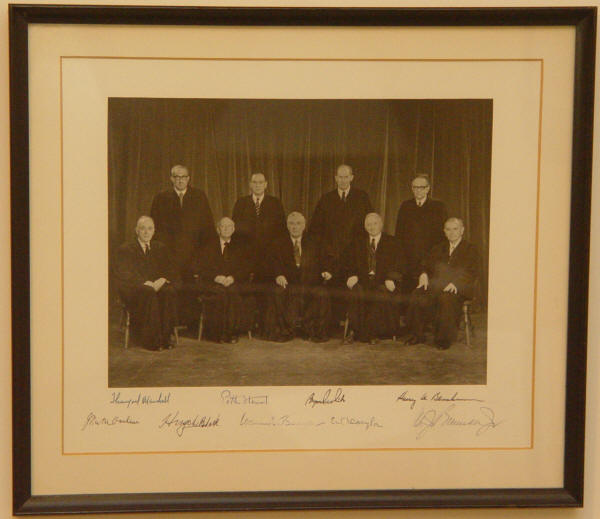
1113901
United States Supreme Court
Circa 1970-1971
Signed Court photograph including five giants among 20th Century Justices
Supreme Court of the United States, 1970-1971. Formal portrait of the Supreme Court, signed by Chief Justice Warren E. Burger and all eight Associate Justices, Warren E. Burger, Hugo L. Black, Wm O. Douglas, John M. Harlan, Wm J. Brennan, Jr., Potter Stewart, Byron R. White, Thurgood Marshall, and Harry A. Blackmun.
This magnificent photograph comes from the estate of Donald Perser, who was Assistant Director and the Director of Membership of the American Judicature Society. It is an approximately 11½" x 13½" black-and-white portrait of the Supreme Court that dates from late 1970 or early 1971. It is dated 3-1-71 on the dust cover on the back of the frame.
This photograph includes five giants among 20th
Century Justices—Black, Douglas, Harlan, Brennan, and Marshall:
● One of the
Court's most forceful personalities, Black was an absolutist on the First Amendment's guarantee of free speech,
insisting that the constitutional directive that "Congress shall make no law" abridging the
freedom of speech meant just that. Black was often labeled an
"activist" because of his willingness to review legislation that arguably
violated constitutional provisions. His philosophical debate with the
conservative Justice Harlan lasted throughout
their tenure on
the Court.
● Douglas, another forceful personality, and like Black an appointee
of President Franklin D. Roosevelt, served longer than any other Justice—36
years, 209 days. Time called him "the most doctrinaire and most
committed civil libertarian ever to sit on the court." Douglas was
also a strong advocate of First Amendment. He was also an outspoken
environmentalist and, during his tenure on the Court, served two years as a
member of the Sierra Club board of directors.
● Harlan was the intellectual leader of the Supreme Court's
conservatives, frequently dissenting from the liberal activist decisions of
the Warren Court. He defended federalism against the centralization of
power, believing that federal courts should not interfere in state and local
matters and that the political process, rather than lawsuits, should be used
to correct political and social ills. He was widely respected, even by
his opponents, for his thoroughness and fairness. He was also respected for his civility: Although he publicly disagreed with Justice Black many times,
privately the two were close friends.
● Brennan, a Democrat, was the most liberal, and most influential, justice of the modern Court. In a tribute to Brennan following his death, Harvard law professor Laurence H. Tribe called him "the principal architect of the nation's system for protecting individual rights." Brennan, he said, "played the pivotal role in . . . building an enduring edifice of common sense and uncommon wisdom that transformed the landscape of America." During nearly 34 years on the Court, Brennan served with 22 other justices, one-fifth of those who had ever served. He wrote an astounding 1,573 opinions: 533 majority opinions, 694 dissents, and 346 concurrences.
●
Marshall, the first African-American to serve on the Supreme Court, was the
great-grandson of a slave. While counsel
for the NAACP, Marshall represented
civil rights claimants all over the United States and won 32 of 35 cases
before the Supreme Court.
Among ![]() them
them![]() were Smith v. Allwright (1940), which declared Texas’
exclusion of black voters from primary elections unconstitutional; Sweatt
v. Painter (1950), which declared "separate but equal"
facilities for black
were Smith v. Allwright (1940), which declared Texas’
exclusion of black voters from primary elections unconstitutional; Sweatt
v. Painter (1950), which declared "separate but equal"
facilities for black![]() professionals
and graduate students in state universities
professionals
and graduate students in state universities![]() unconstitutional; and Brown v. Board of Education (1954), which
declared unconstitutional the racial segregation of public schools. In
1965, President Lyndon B. Johnson appointed him Solicitor General of the
United States, a role in which he won 14 of the 19 cases that he
argued before the Supreme Court on behalf of the government. In 1967,
Johnson appointed him to be an Associate Justice.
unconstitutional; and Brown v. Board of Education (1954), which
declared unconstitutional the racial segregation of public schools. In
1965, President Lyndon B. Johnson appointed him Solicitor General of the
United States, a role in which he won 14 of the 19 cases that he
argued before the Supreme Court on behalf of the government. In 1967,
Johnson appointed him to be an Associate Justice.
This photograph is matted in white and framed in a simple black wood frame. Unfortunately, because of lighting, the photo of the item distorts the actual stark black-and-white coloration of the piece.
The photograph shows a few small creases, not affecting the signatures. The signature of Chief Justice Burger is faded, but readable; the others are all dark. We have not examined the photograph out of the frame, but it appears to be in fine condition.
Framed to an overall size of 15¾” x 13¾".
_____________
This item has been sold, but
click here to see other
Supreme Court items
that we are offering.



